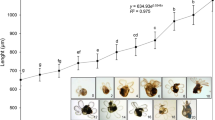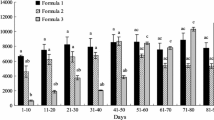Abstract
The effects of an artificial diet on growth, development, reproduction and digestive physiology of Chrysopa septempunctata Wesmael were determined. The results showed that the reproduction was highly correlated with weights of females and activities of trypsin-like and chymotrypsin-like enzymes of C. septempunctata. The influences of diet on the digestive physiology such as digestive enzyme activity of a predator may be used to assess the reproductive potential of a predator, and therefore to provide a way to speed up the development and screening of artificial diets.





Similar content being viewed by others
References
Abdulmadzhid AA (1973) Control of Acyrthosiphon pisum with natural enemies and insecticides. Rastitelna Zashchita 21:39–41
Agusti N, Cohen AC (2000) Lygus hesperus and L. lineolaris (Hemiptera: Miridae), phytophages, zoophages, or omnivores: evidence of feeding adaptations suggested by the salivary and midgut digestive enzymes. J Entomol Sci 35:176–186
Boo KS, Chung IB, Han KS, Pickett JA, Wadhams LJ (1998) Response of the lacewing Chrysopa cognata to pheromones of its aphid prey. J Chem Ecol 24:631–643
Boyd DW Jr, Cohen AC, Alverson DR (2002) Digestive enzymes and stylet morphology of Deraeocoris nebulosus (Hemiptera: Miridae), a predacious plant bug. Ann Entomol Soc Am 95:395–401
Broadway RM, Duffey SS (1988) The effect of plant protein quality on insect digestive physiology and the toxicity of plant proteinase inhibitors. J Insect Physiol 34:1111–1117
Cohen AC (1998a) Solid-to-liquid feeding: the inside(s) story of extra-oral digestion in predaceous Arthropoda. Am Entomol 44:103–116
Cohen AC (1998b) Biochemical and morphological dynamics and predatory feeding habits in terrestrial Heteroptera. In: Coll M, Ruberson JR (eds) Predatory Heteroptera in agroecosystems: their ecology and use in biological control. Thomas Say Publications, Entomological Society of America, Lanham, USA, pp 21–32
Cohen AC, Tang R (1997) Relative prey weight influences handling time and biomass extraction in Sinea confusa and Zelus renardii (Heteroptera: Reduviidae). Environ Entomol 26:559–565
El-Arnaouty SA, Galal H, Beyssat-Arnaouty V, Ferran A, Grenier S (2006) Influence of artificial diet supplements on developmental features of Chrysoperla carnea Stephens. Egypt J Biol Pest Control 16:29–32
Erlanger BF, Kokowsky N, Cohen W (1961) The preparation and properties of two new chromogenic substrates of trypsin. Arch Biochem Biophys 95:271–278
Evans EW (1982) Consequences of body size for fecundity in the predatory stinkbug, Podisus maculiventris (Hemiptera: Pentatomidae). Ann Entomol Soc Am 75:418–420
Felton GW (1996) Nutritive quality of plant protein: sources of variation and insect herbivore responses. Arch Insect Biochem 32:107–130
García M, Farinós GP, Castañera P, Ortego F (2012) Digestion, growth and reproductive performance of the zoophytophagous rove beetle Philonthus quisquiliarius (Coleoptera: Staphylinidae) fed on animal and plant based diets. J Insect Physiol 58:1334–1342
Grenier S, De Clercq P (2003) Comparison of artificially vs. naturally reared natural enemies and their potential for use in biological control. In: van Lenteren JC (ed) Quality control and production of biological control agents: theory and testing procedures. CABI Publications, Wallingford, UK, pp 115–131
Habibi J, Backus EA, Coudron TA, Brandt SL (2001) Effect of different host substrates on hemipteran salivary protein profiles. Entomol Exp Appl 98:369–375
Lin M, Chen H, Wang S, Tong Z (2007) Development of artificial diet for Chrysopa pallens larva. Chin J Biol Control 23:316–321
Medina P, Budia F, Del Estal P, Viñuela E (2004) Influence of azadirachtin, a botanical insecticide, on Chrysoperla carnea (Stephens) reproduction: toxicity and ultrastructural approach. J Econ Entomol 97:43–50
Mochizuki A (1998) Characteristics of digestive proteases in the gut of some insect orders. Appl Entomol Zool 33:401–408
Mohaghegh-Neyshabouri J, De Clercq P, Degheele D (1996) Influence of female body weight on reproduction in laboratory-reared Podisus nigrispinus and Podisus maculiventris (Heteroptera: Pentatomidae). Meded Fac Landbouwk Toeg Biol Wet Univ Gent 61:693–696
Mulligan EA, Ferry N, Jouanin L, Romeis J, Gatehouse AMR (2010) Characterisation of adult green lacewing (Chrysoperla carnea) digestive physiology: impact of a cysteine protease inhibitor and a synthetic pyrethroid. Pest Manag Sci 66:325–336
Oliveira JA, Oliveira MGA, Guedes RNC, Soares MJ (2006) Morphology and preliminary enzyme characterization of the salivary glands from the predatory bug Podisus nigrispinus (Heteroptera: Pentatomidae). Bull Entomol Res 96:251–258
Pappas ML, Broufas GD, Tsarsitalidou OK, Koveos DS (2011) Development and reproduction of the lacewings Dichochrysa flavifrons and Dichochrysa zelleri (Neuroptera: Chrysopidae) fed on two prey species. Ann Entomol Soc Am 104:726–732
Pascual-Ruiz S, Carrillo L, Álvarez-Alfageme F, Ruiz M, Castañera P, Ortego F (2009) The effects of different prey regimes on the proteolytic digestion of nymphs of the spined soldier bug, Podisus maculiventris (Hemiptera: Pentatomidae). Bull Entomol Res 99:487–491
Principi MM, Canard M (1984) Feeding habits. In: Canard M, Semeria Y, New TR (eds) Biology of Chrysopidae. Junk, The Hague, The Netherlands, pp 76–92
Rahbé Y, Deraison C, Bonadé-Bottino M, Girard C, Nardon C, Jouanin L (2003) Effects of the cysteine protease inhibitor oryzacystatin (OC-I) on different aphids and reduced performance of Myzus persicae on OC-I expressing transgenic oilseed rape. Plant Sci 164:441–450
Riddick EW (2009) Benefits and limitations of factitious prey and artificial diets on life parameters of predatory beetles, bugs, and lacewings: a mini-review. BioControl 54:325–339
SAS Institute (2004) SAS/STAT© 9.1 User’s Guide. SAS Institute Inc., Cary, NC, USA
Sattar M, Fatima B, Ahmed N, Abro GH (2007) Development of larval artificial diet of Chrysoperla carnea (Stephens) (Neuroptera: Chrysopidae). Pak J Zool 39:103–107
Sighinolfi L, Febvay G, Dindo ML, Rey M, Pageaux J, Baronio P, Grenier S (2008) Biological and biochemical characteristics for quality control of Harmonia axyridis (Pallas) (Coleoptera, Coccinellidae) reared on a liver-based diet. Arch Insect Biochem 68:26–39
Smith RA, Nordlund DA (2000) Mass rearing technology for biological control agents of Lygus spp. Southwest Entomol 23:121–127
Takesue Y, Yokota K, Nishi Y, Taguchi R, Ikezawa H (1986) Solubilization of trehalase from rabbit renal and intestinal brush-border membranes by a phosphatidylinositol-specific phospholipase C. FEBS Lett 201:5–8
Tauber MJ, Tauber CA, Daane KM, Hagen KS (2000) Commercialization of predators: recent lessons from green lacewings (Neuroptera: Chrysopidae: Chrysoperla). Am Entomol 46:26–38
Thompson SN (1999) Nutrition and culture of entomophagous insects. Annu Rev Entomol 44:561–592
Ulhaq MM, Sattar A, Salihah Z, Farid A, Usman A, Khattak SUK (2006) Effect of different artificial diets on the biology of adult green lacewing (Chrysoperla carnea Stephens.). Songklanakarin J Sci Technol 28:1–8
Watanabe Y, Shimamori Y, Ozaki M, Uchida M, Fujimoto Y (1984) Purification of a membrane-bound neutral endopeptidase from rat kidney and its activation by polyamines. J Biochem 95:1725–1732
Zaki FN, Gesraha MA (2001) Production of the green lacewing Chrysoperla carnea (Steph.) (Neuropt., Chrysopidae) reared on semi-artificial diet based on the algae Chlorella vulgaris. J Appl Entomol 125:97–98
Zanuncio JC, Molina-Rugama AJ, Serrao J, Pratissoli D (2001) Nymphal development and reproduction of Podisus nigrispinus (Heteroptera: Pentatomidae) fed with combinations of Tenebrio molitor (Coleoptera: Tenebrionidae) pupae and Musca domestica (Diptera: Muscidae) larvae. Biocontrol Sci Technol 11:331–337
Zeng F, Cohen AC (2000) Comparison of α-amylase and protease activities of a zoophytophagous and two phytozoophagous Heteroptera. Comp Biochem Phys A 126:101–106
Zhang F, Wang S, Luo C, Chen Y, Li F (2004) Effects of the artificial diets and breeding means on growth and development of Chrysopa septempunctata Wesmael. Plant Prot 30:36–40
Zhao J (1988) Studies on the bionomics of Chrysopa septempunctata Wesmael. Acta Phytophyl Sin 15:123–127
Acknowledgments
We thank Danjuan Jin, Heqing Zhang and Shen Zhang for the technical assistance in this study. We also thank the editors and reviewers for their comments and suggestions. This work was supported by 973 Program 2013CB127602 and the agriculture cooperative research fund 2011-G4.
Author information
Authors and Affiliations
Corresponding author
Additional information
Handling Editor: Patrick De Clercq.
F. Liu and C. Liu have contributed equally to this study.
Rights and permissions
About this article
Cite this article
Liu, F., Liu, C. & Zeng, F. Effects of an artificial diet on development, reproduction and digestive physiology of Chrysopa septempunctata . BioControl 58, 789–795 (2013). https://doi.org/10.1007/s10526-013-9529-8
Received:
Accepted:
Published:
Issue Date:
DOI: https://doi.org/10.1007/s10526-013-9529-8




